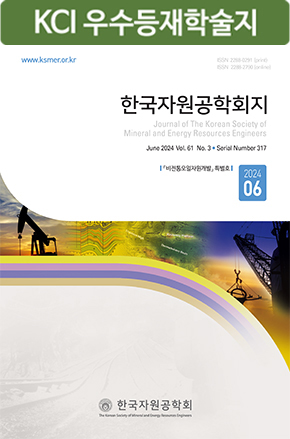Research Paper
- Cheong, Y.W. and Kang, S.S., 2004, “Changes in characteristics of sludge and water quality of acid mine drainage by neutralization-sedimentation method of sludge return,” J. of The Korean Society of Mineral and Energy Resources Engineering, Vol. 41, No. 5, pp. 389-394.
- Cravotta III, C.A., 2008, “Dissolved metals and associated constituents in abandoned coal-mine discharges, Pennsylvania, USA. Part 2: Geochemical controls on constituent concentrations,” Applied Geochemistry, Vol. 23, pp. 203-226.
- Goldberg, P., 2001, “CO2 Mineral sequestration Studies- Introduction, Issues and Plans, Workshop on CO2 Sequestration with Minerals,” August 8.
- Ha, H., Park, S.S. and Lee H.C., 1992, “Studies on the preparation of precipitated calcium carbonate(Ⅰ): Formation and transformation of amorphous calcium carbonate,” J. of Korean Ind. & Eng. Chemistry., Vol. 3, No. 3, pp. 522-526.
- Herrera, S.P., Uchiyama, H., Igarashi, T., Asakura, K., Ochi, Y., Ishizuka, F. and Kawada, S., 2007, “Acid mine drainage treatment through a two-step neutralization ferrite-formation process in northern Japan: Physical and chemical characterization of the sludge,” Mineral Engineering, Vol. 20, pp. 1309-1314.
- Huijgen, W.J.J. and Comans, R.N.J., 2003, Carbon dioxide sequestration by mineral carbonation, Energy Research Centre of the Netherlands, Petten, The Netherlands.
- Ji, S.W., Cheong, Y.W., Baek, S.H., Kim, Y.S., Ko, J.I., Kim, S.J., Yim, G.J. and Lee, H.S., 2007, “Prediction of acid rock drainage (ARD) generation on construction sites and its application,” J. of The Korean Society of Mineral and Energy Resources Engineering, Vol. 44, No. 1, pp. 82-93.
- Jo, Y.D., Kim, H.S. and Ahn, J.W., 2007, “Precipitation characteristics of heavy metals in coal mine drainage,” J. Miner. Soc. Korea, Vol. 20, No. 2, pp. 125-134.
- Johnson, D.B. and Hallberg, K.B., 2005, “Acid mine drainage remediation options: A review,” Science of the Total Environmental, Vol. 338, pp. 3-14.
- Juvekar, V.A. and Sharma, M.M., 1973, “Absorption of CO2 in a suspension of lime,” Chemical Engineering Science, Vol. 28, pp. 825-837.
- Kang, D.H., Kwon, B.H., Yu, H.S. and Kim, S.O., 2010, “Discharge characteristics of heavy metals in acid mine drainage from the abandoned Ilkwang mine,” The Journal of Engineering Geology, Vol. 20, No. 1, pp. 79-87.
- Kang, H., Park, S.M., Jang, Y.D. and Kim, J.J., 2008, “Studies for neutralization teratment of acid mine drainage from abandoned mine,” Econ. Environ. Geol., Vol. 41, No. 1, pp. 33-45.
- Kim, J.B., Oh, J.I. and Park, C.S., 2002, “AMD(acid mine drainage) neutralization using recycled-concrete aggregates,” J. of Korean Society of Environmental Engineers, Vol. 24, No. 1, pp. 21-30.
- Kim, J.Y., Chon, H.T. and Jung, M.C., 1999, “Assessment of applicability of marine shells as neutralizer for the treatment of acid mine drainage,” J. of The Korean Society of Mineral and Energy Resources Engineering, Vol. 36, No. 5, pp. 319-327.
- Korea Mine Reclamation Corporation (MIRECO), 2012, White paper on mine damage management, p. 35.
- Kuyucak, N., Chavez, J., Sastillo, J. and Ruiz, J., 2003, “Technical feasibility studies and uses of treated acid mine drainage at Kingsmill tunnel, Peru,” Proceedings of 6th ICARD, Carins, Australia, pp. 771-778.
- Lee, H.C., Min, K.W. and Lee, W.S., 2012, “A fundamental study on stabilization and CO2 fixation of mine tailings using mineral carbonation,” J. of The Korean Society of Mineral and Energy Resources Engineering, Vol. 49, No. 1, pp. 26-36.
- Lee, H.C., Min, K.W. and Seo, E.Y., 2013, “A study on removal of aqueous arsenic using the carbonation process,” J. of The Korean Society of Mineral and Energy Resources Engineering, Vol. 50, No. 1, pp. 70-79.
- Lyu, K.K., Lee, S.H., Ann, J.M. and Park, J.K., 1996, “The study on neutralization treatment for acid mine drainage by using limestone,” J. of The Korean Society of Mineral and Energy Resources Engineering, Vol. 33, pp. 226-232.
- Lyu, S.G., Ryu, S. and Sur, G.S., 1998, “Quantitative analysis of calcium carbonate polymorphs by X-ray diffraction,” Korean Chemical Engineering Research, Vol. 36, No. 4, pp. 543-547.
- McDonald, D.M., Webb, J.A. and Musgrave, R.J., 2006, “The effect of neutralization method and reagent on the rate of Cu and Zn release from acid rock drainage treatment sludges,” Proceedings of the 7th ICARD, St. Louis, MO, USA, pp. 1198-1218.
- Murdock, D.J., Fox, J.R.W. and Bensley, J.G., 1994, “Treatment of acid mine drainage by the high density sludge process,” Proceedings of the International Land Reclamation and Mine Drainage Conference and Third International Conference on the Abatement of Acid Drainage, Pittsburgh, April, Vol. 1, pp. 241-249.
- National lime association, 2007, Lime Terminology, Standards & Properties.
- Oh, J.I. and Shim, Y.S., 2003, “Statistical analysis of water quality of domestic acid mine drainage (AMD),” J. of the Korean Society of Civil Engineers, Vol. 23, No. 6B, pp. 587-596.
- Park, H.S., 2011, Field application and maintenance of the passive treatment system depending on chemical characteristics of mine water, Ph.D Thesis, Chonnam National University, Gwangju.
- Park, S.S., Kim, J.H. and Lee, H.C., 1995, “Study on the preparation of calcium carbonate from the waste solution of industry,” J. of Korea Solid Wastes Engineering Society, Vol. 12, No. 2, pp. 199-206.
- Park, Y.K., Park, J.S. and Hong, S.J., 2005, “Neutralization treatment of acid mine drainage using Ca(OH)2,” J. Korean Ind. Eng. Chem., Vol. 16, No. 3, pp. 391-396.
- Shin, D.W., 1984, “Status and prospects of the inorganic industry: lime・limestone industry,” Chemical Industry and Technology, Vol. 2, No. 1, pp. 40-48.
- US EPA, 1983, Design manual: Neutralization of acid mine drainage.
- Younger, P.L., Banwart, S.A. and Hedin, R.S., 2002, Mine Water hydrology, pollution, remediation, Kluwer Academic Publishers, pp. 292-294.
- Publisher :The Korean Society of Mineral and Energy Resources Engineers
- Publisher(Ko) :한국자원공학회
- Journal Title :Journal of the Korean Society of Mineral and Energy Resources Engineers
- Journal Title(Ko) :한국자원공학회지
- Volume : 51
- No :1
- Pages :9-18
- DOI :https://doi.org/10.12972/ksmer.2014.51.1.9



 Journal of the Korean Society of Mineral and Energy Resources Engineers
Journal of the Korean Society of Mineral and Energy Resources Engineers








